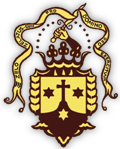
Messages given by Saint Pío of Pietrelcina to Clemente Domínguez y Gómez,
today Pope Saint Gregory XVII, the Very Great
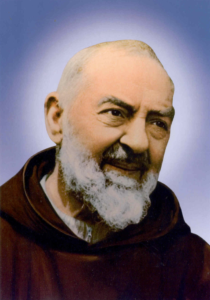 Dnia 5 lipca 1970
Dnia 5 lipca 1970
San Giovanni Rotondo, Włochy. Grobowiec Ojca Pio z Pietrelciny. Ukazał się Ojciec Pio Klemensowi i powiedział: “Synu mój: Nie jest moim kaprysem Różaniec z Ojcze Nasz, Jest potrzebą, aby zmienić przewrotność ludzkości. Was błogosławię.”
Dnia 20 grudnia 1974
(San Giovanni Rotondo. Grobowiec Ojca Pio. Rano, Kapłan z Wenezueli celebrował Świętą Mszę Trydencką na ołtarzu, który jest blisko grobowca Ojca Pio. Po Mszy Świętej, modląc się tam wszyscy, Klemens Dominguez miał następującą lokucję:)
Ojciec Pio z Pietrelciny
“Dzieci moje: Was ojcowsko błogosławię. Oczekiwałem waszej wizyty z otwartymi ramionami, jako że ten mój syn obiecał wizytę w akcji dziękczynienia. Z Woli Najwyższego ja jestem Protektorem El Palmar i Vergel. Trzeba, aby zakonnice i zakonnicy z Vergel mnie wzywali częściej. Ja poprę sprawę Vergel. Was błogosławię.” (Stwierdzamy, że Klemens Dominguez ofiarował wizytę grobowca Ojca Pio, w akcji dziękczynienia, jeśli wręczy bezpośrednio Dokumenty Ojcu Świętemu. Z powodu trudności ekonomicznej, Manuel Alonso starał się wrócić do Hiszpanii. Ale Klemens Dominguez chciał za wszelką cenę wykonać obietnicę i poszliśmy wszyscy do grobowca Ojca Pio. Tego samego dnia 20 grudnia, rano, wyjechaliśmy z San Giovanni Rotondo do Monte Santo Angelo, gdzie jest Sanktuarium Świętego Michała Archanioła. Potem odwiedziliśmy Sanktuarium w Loreto i tego samego popołudnia wyjechaliśmy do miasta Sigillo, gdzie jest wielu czcicieli El Palmar. Przybyliśmy wieczorem i przyjęto nas jak innym razem, z autentyczną miłością braci. Spaliśmy w klasztorze Matek Augustynek Świętej Anny.)
Dnia 9 lipca 1980
(O 12 w południe przybyliśmy do San Giovanni Rotondo, weszliśmy do Kościoła, zeszliśmy do krypty i modliliśmy się przed grobem wielkiego Świętego Męczennika, Świętego Pio de Pietrelcina, kanonizowanego przez Jego Świątobliwość Papieża Grzegorza XVII, który po raz pierwszy, jako Papież, klęczał i modlił się przed relikwiami umiłowanego świętego, który tyle razy ukazywał się w El Palmar de Troya. Momenty nieopisanej emocji! W czasie modlitwy, Święty Pio ukazał się Ojcu Świętemu i dał mu następujący Przekaz, teraz o 12,30 w południe:)
Święty Pio de Pietrelcina
“Najukochańszy Zastępco Naszego Pana Jezusa Chrystusa:
Muszę okazać z wielką radością uciechę, którą czuję w moim sercu z waszej apostolskiej wizyty, z którą wizytą naprawiacie trochę za wiele obelg, które Jezus otrzymuje w tym miejscu.
Ja nadal jestem wielkim opiekunem El Palmar de Troya i zawsze tak pozostaję aż do najmniejszego szczegółu dla dobra Wielkiego Dzieła w El Palmar.
Gorąco pragnę, aby budowle w El Palmar przewyższyły te dotychczasowe; dla których nakazująco proszę wiernych, aby wykazali swoją hojność nader obficie.
Żałosne i smutne musieć zawsze prosić wiernych, kiedy byłoby bardziej przyjemne Bogu, aby ochotniczo wyszła hojność od nich samych.
Ja, jako Kapitan Wojska Marii chronić będą w najszczególniejszy sposób, w dniach kary i ciemnicy, tych wiernych, którzy są hojni z El Palmar, według ich prawdziwych i autentycznych możliwości; jako że wielu może. a nie chce, a inni chcą i nie mogą. Was błogosławię.”
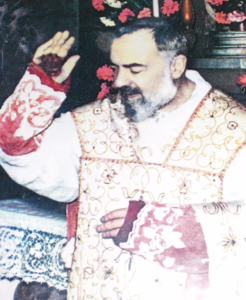 Dnia 23 września 1974
Dnia 23 września 1974
Hołd Ojcu Pio z Pietrelciny
(Święte Miejsce Lentiska w El Palmar de Troya. O godzinie 1 rano, Klemens widział Najświętszą Dziewicę Marię. Potem Naszego Pana Jezusa Chrystusa i Ojca Pio.
W TYM DNIU PRZYPADA SZÓSTA ROCZNICA ŚMIERCI OJCA PIO Z PIETRELCINY: W San Giovanni Rotondo, dnia 23 września 1968. Ojciec Pio oddał swoją duszę Bogu, o 2,30 rano, wymawiając najsłodsze słowa ”Jezus i Maria”. Ojciec Pio jest figurą związaną z Objawieniami w El Palmar de Troya. Jego Objawienia się widzącym w tym Świętym Miejscu są bardzo częste. Były czasy, kiedy Ojciec Pio ukazywał się w El Palmar we wszystkie dni, czasem kilkakrotnie dziennie. Oprócz tego, jego obecność w El Palmar dała się zauważyć wielu pielgrzymom prze pewne cudowne znaki, między nimi perfum. Ojciec Pio stał się widzialny po raz pierwszy w El Palmar de Troya, kiedy jeszcze był żywy, krótko przed rozpoczęciem tych Objawień. Nie jest dziwna predylekcja tego Świętego stygmatyka dla El Palmar de Troya, jako że on sam prorokował, że Najświętsza Maria ukaże się w pewnej wiosce położonej między miastami Sewillą i Kadyksem w Hiszpanii. Wiele mamy do zawdzięczenia czciciele z El Palmar Ojcu Pio, jak że ustawicznie strzeże i pilnuje tego Świętego Miejsca. OJCIEC PIO NAS NAUCZAŁ, W JEDNYM ZE SWYCH OBJAWIEŃ, ODMAWIANIA ŚWIĘTEGO RÓŻAŃCA POKUTNEGO Z OJCZE NASZ, ZWANYM TAKŻE OJCA PIO. Ojciec Pio mówił często do widzących z El Palma de Troya; i przez nich przekazywał błogosławieństwa, rady, orientacje, słowa zachęty, nagany, uwagi etc., etc., wielu licznym pielgrzymom, którzy wizytowali to Święte Miejsce. Wybitna Reformatorka Karmelu, Święta Teresa od Jezusa, powiedziała Klemensowi Dominguez, abyśmy nie zapominali prosić Ojca Pio o pośrednictwo; także ujawniła wiele cierpienia Świętemu Stygmatykowi i wysoką chwałę w Niebie. Oprócz tego, Święta Teresa od Jezusa powiedziała Klemensowi o Ojcu Pio:) “Musicie modlić się o przyspieszenie jego kanonizacji. Jest moim życzeniem podzielanym z wolą Dziewicy Marii, aby po jego kanonizacji miał Ołtarz Uprzywilejowany w przyszłej Kaplicy tego Świętego Miejsca, aby w dniach ciemnicy was chronił.” (Misja Ojca Pio, w Ostatnich Czasach jest o nadzwyczajnej doniosłości.
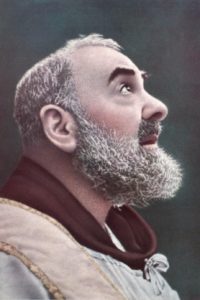 Przypominamy Przekaz dany przez Ojca Pio Klemensowi Dominguez przed jego Grobowcem w San Giovanni Rotondo; Ojciec Pio powiedział:) “Ja byłem wyznaczony przez Naszego Pana Jezusa Chrystusa na kierowanie Apostołami Mariańskimi Ostatnich Czasów. Proszę wszystkich, którzy chcą tworzyć krucjatę Królestwa Marii, aby mię wzięli za Kapitana Wojsk Mariańskich. Was zapewniam, że Maria będzie tryumfować…” (Dnia 23 sierpnia1972, z motywu pielgrzymki pewnego włoskiego Kapłana i różnych wiernych, Ojciec Pio ukazał się Klemensowi Dominguez i powiedział mu:) “Jako dobry strażnik tego Świętego Miejsca jestem tu pożegnać was. Dziecinki moje: Ufajcie mi! JA STRZEGĘ TEGO MIEJSCA OD WROGÓW. TU JESTEM U DRZWI STRZEGĄCY TEGO BŁOGOSŁAWIONEGO MIEJSCA. Dlatego chciałem ukazać się tu znowu.” (Niech będzie to serdeczne wspomnienie o Ojcu Pio, w szóstą rocznicę jego śmierci, aktem wdzięczności ze strony wszystkich czcicieli z El Palmar ku temu gigantycznemu Świętemu. Wieczorem celebrowano Świętą Mszę ku czci Ojca Pio. W Lentisku El Palmar czci się małą podobiznę Ojca Pio, wśród innych podobizn Świętych.)
Przypominamy Przekaz dany przez Ojca Pio Klemensowi Dominguez przed jego Grobowcem w San Giovanni Rotondo; Ojciec Pio powiedział:) “Ja byłem wyznaczony przez Naszego Pana Jezusa Chrystusa na kierowanie Apostołami Mariańskimi Ostatnich Czasów. Proszę wszystkich, którzy chcą tworzyć krucjatę Królestwa Marii, aby mię wzięli za Kapitana Wojsk Mariańskich. Was zapewniam, że Maria będzie tryumfować…” (Dnia 23 sierpnia1972, z motywu pielgrzymki pewnego włoskiego Kapłana i różnych wiernych, Ojciec Pio ukazał się Klemensowi Dominguez i powiedział mu:) “Jako dobry strażnik tego Świętego Miejsca jestem tu pożegnać was. Dziecinki moje: Ufajcie mi! JA STRZEGĘ TEGO MIEJSCA OD WROGÓW. TU JESTEM U DRZWI STRZEGĄCY TEGO BŁOGOSŁAWIONEGO MIEJSCA. Dlatego chciałem ukazać się tu znowu.” (Niech będzie to serdeczne wspomnienie o Ojcu Pio, w szóstą rocznicę jego śmierci, aktem wdzięczności ze strony wszystkich czcicieli z El Palmar ku temu gigantycznemu Świętemu. Wieczorem celebrowano Świętą Mszę ku czci Ojca Pio. W Lentisku El Palmar czci się małą podobiznę Ojca Pio, wśród innych podobizn Świętych.)
Biography of Saint Pio of Pietrelcina
23rd of September

Presbyter. Religioso. Doctor. Great Mystic. Stigmatic. Spiritual Martyr. Apostle of the Penitential Rosary. Eminent Protector of the Carmelites of the Holy Face. Called Francis Forgione de Nunzio in the world, he was born in Pietrelcina, Benevento, Campania, Italy, on the 25th of May 1887, into the bosom of a modest farming family. Son of Gracio Maria and Maria Josepha, he was the fourth of their seven children. His family was so poor that twice his father had to emigrate to America. His early years went by in the silence of his town, dedicated to agricultural labour. His health precarious, he was an exemplary Christian. He liked quietness and solitude and regularly attended the parish church, where he prayed for long spells. At the age of five years his first mystical phenomena began, which he told no one about until years later. He did his primary schooling in Pietrelcina. From an early age he began to feel the desire of consecrating himself wholly to God.
Saint Pio entered the Capuchins of the Morcone priory on the 6th of January 1903, and on the 22nd of the same month received the religious habit and the name of Pio. On the 25th of January 1904, he was transferred to the Saint Elias priory in Pianisi, Campobasso province, where he began his philosophy studies, finishing them in 1906. At that time other mystical phenomena reappeared in his life. His superiors valued his perseverance, readiness and obedience. On the 27th of January 1907, he took his perpetual vows. He did his Theological studies at the Capuchin formation centres of Serracapriola and Montefusco.
He did not shine out for his intelligence, rather for his behaviour, ever humble, gentle and obedient. From the first months of the year 1909 until February 1916, owing to a mysterious illness, and except for some intervals, he lived in his family home in Pietrelcina, his native town, in a climate more favourable to his health. There he continued his formation in Theology and forced himself to live a life of prayer, taking part in the religious services at the Parish Church. He was ordained Priest on the 10th of August 1910 in Benevento cathedral, and with great joy afterwards celebrated his first Mass in the church of Pietrelcina.
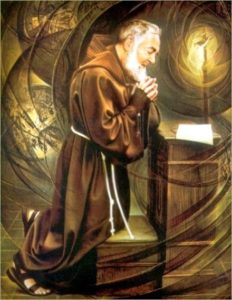
His peace was not lasting, however, as he was direly afflicted by unclean temptations and the demon disturbed his soul in manifold ways. Saint Pio’s struggle against the infernal enemy rose to unknown heights. On the 28th of March 1913, he had a vision of Jesus Christ suffering, completely disfigured and in a pitiable state. Christ and Mary consoled him with frequent apparitions and at the same time the devil sought to make life impossible for him. In September 1910 he received the stigmata, invisible, but painful at certain times. In the years 1915 to 1917, during World War I, with prolonged absences for health reasons, he served in the army as a soldier in Benevento, Naples and Foggia. On the 4th of September 1916, Saint Pio was sent to the priory of San Giovanni Rotondo, a small town on Mount Gargano, where he was to live for the remaining fifty- two years of his life. His entry into this priory marked a new stage in his ministry of spiritual direction. At first he was entrusted with the spiritual formation of the small priory school. On the 20th of September 1918, he received the visible stigmata of Christ’s Passion. He had scarcely finished saying Holy Mass, while in the choir making his thanksgiving, he saw the Holy Christ of the priory crucifix come to life, and the Lord’s feet, hands and side bleed profusely. At this vision the holy Capuchin felt as if he were dying, and when the vision ceased he realized that his feet, hands and side were transpierced, blood gushing forth. Regarding the reception of the wounds, the Saint himself relates: “How often Jesus said to me: 'You would have forsaken Me, My son, were I not to have crucified you. Beneath the cross one learns to love, and I do not give the cross to the whole world, but only to the souls I love’.”
These and other extraordinary charisms promptly brought him world-wide fame, but also occasioned him endless problems and suffering. In 1919 the stigmata were examined by several doctors, who were of the opinion that they were genuine wounds not brought about by any natural cause. Nonetheless, the following year the Milanese Franciscan priest Augustine Gemelli, a trained doctor, examined the wounds and furnished the Holy Office with a negative report, which served as an argument for the detractors of the holy Capuchin. A month later Monsignor Sily, after visiting Saint Pio, on his return to the Vatican gave a report of praise on the case to Pope Saint Benedict XV the Great, who gave the holy Capuchin his constant support. Many pilgrims came to San Giovanni Rotondo priory, and Saint Pio confessed men and women daily for long hours. Aristocrats, workers, children and the elderly came to see the saintly stigmatic, who celebrated Holy Mass in the presence of a fervent multitude. The people crowded together to hear his Mass, receive spiritual counsel, or merely to touch him and take away relics. On the 6th of February 1922, Pope Saint Pius XI the Great was elected. On the 11th of May that same year the first disciplinary measures were taken against Saint Pio, who received the order to celebrate Holy Mass privately early in the morning, and was forbidden to bless the faithful or show his stigmatized hands. Notwithstanding, favourable medical and spiritual reports were sent to the Vatican. In June 1922 the corrupt, lecherous and simoniacal bishop of Manfredonia, Paschal Gagliardi, in the presence of cardinals and bishops of the Congregation of the Consistory, calumniously stated: “I myself have seen Padre Pio powder and perfume himself, and during a visit to the priory I discovered a bottle of nitric acid with which he caused his stigmata and a bottle of eau de Cologne with which to perfume them. I have said it on oath. Padre Pio is possessed by the devil and the monks of San Giovanni Rotondo are a bunch of swindlers.”
On the 31st of May 1923, the Holy Office emitted a negative decree on the holy Capuchin. In a later letter the possibility of transferring him was debated. Saint Pio faced up to his future serenely, saying: “They may do with me as they please, as long as they do not forbid me to say Mass and receive Jesus into my heart.” From the 25th of June 1923, several thousand people, led by the mayor of San Giovanni Rotondo, demonstrated before the priory doors demanding the suspension of disciplinary sanctions. The next day, Saint Pio said Mass in the conventual church in the presence of his faithful. In July that same year the General of the Capuchins received the order from the Holy Office to transfer Saint Pio to the Ancona priory. In San Giovanni Rotondo the tension became extreme, since all demanded that the holy Capuchin remain in his priory. The transfer was never carried out. On the 24th of June 1924, the Holy Office requested the faithful not to have any type of correspondence with Saint Pio, thereby making his isolation complete. On the 11th of July 1926, the Holy Office requested the faithful to refrain from visiting him. In May 1931 a Decree of the Holy Office deprived the holy Capuchin of all the faculties of the priestly ministry except celebrating Holy Mass privately, but not in the public church. On the 13th of March 1933, Pope Saint Pius XI the Great sent a commission to visit Saint Pio, and the favourable report it sent to the Pope allowed the situation to change, to the great enthusiasm of the people. On the 14th of July 1933, by a Decree of the Holy Office he was authorized to celebrate Holy Mass in public and hear confessions. Saint Pio, therefore, enjoyed relative freedom and returned to his activity as director of consciences. His spiritual children increased constantly and his confessional was never empty, since thousands of pilgrims came to the priory every day. On the 2nd of March 1939, Pope Saint Pius XII the Great was elected.
World War II brought misfortune and suffering to San Giovanni Rotondo, and until the war’s end the Capuchin priory received soldiers from the warring armies, all receiving the same attention from the holy Capuchin. In 1940 Saint Pio conceived the idea of founding a house for the sick and entrusted it to three doctors, who set up a committee to carry out the work. As from 1941 the committee received considerable sums of money. The building of the Casa Sollievo della Sofferenza (House for the relief of suffering) began on the 19th of May 1947, and the great work was concluded in December 1949. Some generous donors continued to give large sums of money. Saint Pio’s fame reached its zenith in this period, since he was protected by the Holy Office, praised by the press and admired by the multitudes. However, envy reared its head at an unexpected time, and on the 16th of January 1952, the Holy Office sent a letter to the superior-general of the Capuchins pointing out numerous infringements of Church law in the Capuchin priory. Months later, eight biographies of Saint Pio were placed on the Index. The inauguration of the Casa Sollievo della Sofferenza took place on the 5th of May 1956, presided over by Cardinal Jacob Lercaro, Archbishop of Bologna. Many thousands of people, among them journalists, politicians and doctors, attended the ceremony. Pope Saint Pius XII the Great, by way of a telegram, sent his congratulations for the great work and his paternal apostolic blessing to Saint Pio, to the staff and to those attending. Saint Pio celebrated Holy Mass in front of the hospital.
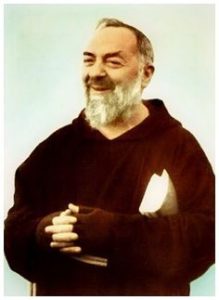 From 1957, however, fresh persecution against Saint Pio of Pietrelcina began. His enemies now accused him of handling great amounts of money, since he received considerable sums in alms to carry out his work. Pope Saint Pius XII, one of the great defenders of the holy Capuchin, died on the 9th of October 1958. The honest and competent administrator of the Casa Sollievo, Angel Battisti, sent a statement of accounts to the Holy See every year. Bishops and Religiosos tried to get their hands on the donations Saint Pio received for his work. It would be tedious to speak of matters related to this money. Some Italian bishops declared themselves against the holy Capuchin.
From 1957, however, fresh persecution against Saint Pio of Pietrelcina began. His enemies now accused him of handling great amounts of money, since he received considerable sums in alms to carry out his work. Pope Saint Pius XII, one of the great defenders of the holy Capuchin, died on the 9th of October 1958. The honest and competent administrator of the Casa Sollievo, Angel Battisti, sent a statement of accounts to the Holy See every year. Bishops and Religiosos tried to get their hands on the donations Saint Pio received for his work. It would be tedious to speak of matters related to this money. Some Italian bishops declared themselves against the holy Capuchin.
One of them was the perverse, covetous Bortignon, bishop of Padua who, on the 2nd of July 1959, presented Pope Saint John XXIII with a negative report. In 1960 unrest returned to the San Giovanni Rotondo priory. A Holy Office prelate was dispatched to the priory and sent a favourable report on Saint Pio, guaranteeing sound management of the Casa Sollievo. But his enemies, to bring down Saint Pio of Pietrelcina, carried out the hellish scheme of placing three microphones so as to catch him out in whatever he said: one in his cell, another in the parlour and another in his confessional. Everything was planned by certain cardinals, bishops, the Superior-General of the Order and other immediate superiors. The listening began on the 9th of May 1960, and everything was recorded on magnetic tapes. Perverse bishop Bortignon presented a lengthy accusatory report to the Holy Office tribunal, in which Saint Pio was accused of a “charismatic schism”. On the 16th of October an Italian periodical portrayed Saint Pio as the “richest Capuchin in the world.” Also, on the 5th of November in the year 1960, fresh restrictive measures were taken against the holy Capuchin, to limit his contact with the faithful, and a door of iron bars was placed at the entrance to the church where he celebrated Holy Mass. The holy Capuchin was compelled to live like a recluse, forcibly isolated, except for confessions, though strictly monitored. His time for celebrating Holy Mass was restricted as well. Saint Pio found consolation only in prayer and meditation, living with his eyes fixed only on the crucified Christ. 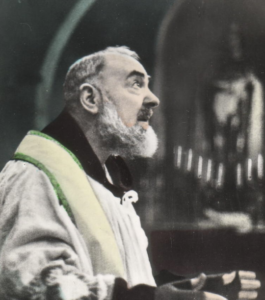 He was informed that the Holy See wished to become the proprietor of the House-Hospital of San Giovanni Rotondo, to which Saint Pio agreed, donating his goods by way of a legal act. The holy Capuchin encountered support only in his many spiritual sons and daughters, ever willing to lighten his sufferings. On the 19th of June 1963, Pope Saint Paul VI was elected. From then on the situation changed, and on the 30th of January 1964, saintly Cardinal Ottaviani informed the Capuchin provincial that Saint Paul VI intended to restore full freedom to Saint Pio. The latter, his physical stamina now reduced, had to be held up at the Altar when he celebrated Holy Mass. On the 22nd of September 1968, the Capuchins solemnly celebrated the fiftieth anniversary of Saint Pio’s stigmatization, and thousands of pilgrims came to the San Giovanni Rotondo priory. The holy Capuchin, practically dying, celebrated Holy Mass in their presence, and at its conclusion suddenly collapsed in the presence of all. The following day, the 23rd of September 1968, after receiving the Last Sacraments, Saint Pio died in holiness in his cell in the San Giovanni Rotondo priory, uttering the names of Jesus and Mary, and the visible marks of the stigmata vanished from his body.
He was informed that the Holy See wished to become the proprietor of the House-Hospital of San Giovanni Rotondo, to which Saint Pio agreed, donating his goods by way of a legal act. The holy Capuchin encountered support only in his many spiritual sons and daughters, ever willing to lighten his sufferings. On the 19th of June 1963, Pope Saint Paul VI was elected. From then on the situation changed, and on the 30th of January 1964, saintly Cardinal Ottaviani informed the Capuchin provincial that Saint Paul VI intended to restore full freedom to Saint Pio. The latter, his physical stamina now reduced, had to be held up at the Altar when he celebrated Holy Mass. On the 22nd of September 1968, the Capuchins solemnly celebrated the fiftieth anniversary of Saint Pio’s stigmatization, and thousands of pilgrims came to the San Giovanni Rotondo priory. The holy Capuchin, practically dying, celebrated Holy Mass in their presence, and at its conclusion suddenly collapsed in the presence of all. The following day, the 23rd of September 1968, after receiving the Last Sacraments, Saint Pio died in holiness in his cell in the San Giovanni Rotondo priory, uttering the names of Jesus and Mary, and the visible marks of the stigmata vanished from his body.
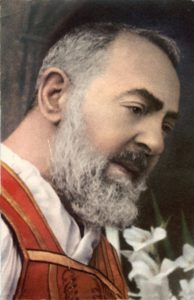 Pope Saint Gregory XVII the Very Great, de Glória Olívæ, in his Tenth Pontifical Document, dated the 12th of September 1978, Solemnly Beatified and Canonized Saint Pio of Pietrelcina. The Supreme Palmarian Pontiff, in the mentioned Document, among others, made the following statements: “We, as Universal Doctor of the Church, by means of the present Pontifical Document, now afford some details on the life and work of the Italian Capuchin priest, Padre Pio of Pietrelcina. We set forth some of the chief motives that move Us in this holy cause, to wit: The one true Church founded by Our Lord Jesus Christ upon the solid rock of Peter, called in truth the One, Holy, Catholic and Apostolic Church, is rooted in the Holy Apostolic See of El Palmar de Troya, a place closely linked to Venerable Padre Pio. We, as Common Father of the whole Church, and assisted by the Holy Spirit, believe, confess and acknowledge the heroic virtues of the eminent Capuchin Priest We present today as model for the faithful.
Pope Saint Gregory XVII the Very Great, de Glória Olívæ, in his Tenth Pontifical Document, dated the 12th of September 1978, Solemnly Beatified and Canonized Saint Pio of Pietrelcina. The Supreme Palmarian Pontiff, in the mentioned Document, among others, made the following statements: “We, as Universal Doctor of the Church, by means of the present Pontifical Document, now afford some details on the life and work of the Italian Capuchin priest, Padre Pio of Pietrelcina. We set forth some of the chief motives that move Us in this holy cause, to wit: The one true Church founded by Our Lord Jesus Christ upon the solid rock of Peter, called in truth the One, Holy, Catholic and Apostolic Church, is rooted in the Holy Apostolic See of El Palmar de Troya, a place closely linked to Venerable Padre Pio. We, as Common Father of the whole Church, and assisted by the Holy Spirit, believe, confess and acknowledge the heroic virtues of the eminent Capuchin Priest We present today as model for the faithful. 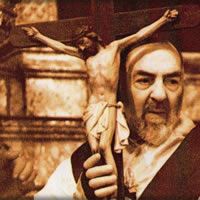 We know the heroic, wonderful and beautiful life, adorned with the aureole of holiness, of this sublime Capuchin. We declare that Padre Pio lived an intense and profound martyrdom for more than fifty years. Padre Pio received the stigmata of the Passion of Our Lord Jesus Christ. Through them he shared in the Sacred Passion of Christ with great intimacy and profundity. We declare that Padre Pio lived a life wholly given up to God and to the service of souls. He lived an exemplary spiritual life. He gave himself up completely to prayer and penance, and constantly practised true charity. We declare that Padre Pio suffered continual persecution, misunderstanding, intense pains of the spirit and of the flesh.
We know the heroic, wonderful and beautiful life, adorned with the aureole of holiness, of this sublime Capuchin. We declare that Padre Pio lived an intense and profound martyrdom for more than fifty years. Padre Pio received the stigmata of the Passion of Our Lord Jesus Christ. Through them he shared in the Sacred Passion of Christ with great intimacy and profundity. We declare that Padre Pio lived a life wholly given up to God and to the service of souls. He lived an exemplary spiritual life. He gave himself up completely to prayer and penance, and constantly practised true charity. We declare that Padre Pio suffered continual persecution, misunderstanding, intense pains of the spirit and of the flesh. 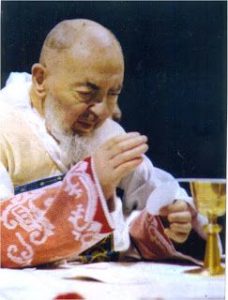 He endured all his sufferings with admirable selflessness for the love of God and His Church. We declare that the life of Padre Pio was that of a true martyr. We know that the Holy Office condemned him unjustly five times, which greatly increased his martyrdom. In the same way he suffered intensely when a group of clerics, made up of cardinals, bishops, the Father General of the Order and immediate superiors, committed the sacrilege of violating the sacred seal of Confession, by secretly installing microphones in the confessional. Undoubtedly this was a satanic ploy to try to bring down Padre Pio. Sadly, Our Revered Predecessor, Pope John XXIII, counselled by that accursed band, also became a persecutor of Padre Pio. It was a case unheard-of in the history of the Church. Despite all this, Padre Pio remained steadfast, and offered up everything united to the Passion of Our Lord Jesus Christ and the Dolours of the Most Holy Virgin Mary. We declare that Padre Pio spent his life doing good, in imitation of the Divine Master. We declare as well, by way of information, that Padre Pio was favoured by God with innumerable charisms, visions, stigmata, levitations and other mystical mysteries. Padre Pio left a great constellation of spiritual children all over the world. The spiritual children of Padre Pio always found in him a model of exemplary Christian life. We remind all the faithful that Our Revered Predecessor, Pope Paul VI, rehabilitated the unforgettable spiritual memory of the exemplary life of Padre Pio.
He endured all his sufferings with admirable selflessness for the love of God and His Church. We declare that the life of Padre Pio was that of a true martyr. We know that the Holy Office condemned him unjustly five times, which greatly increased his martyrdom. In the same way he suffered intensely when a group of clerics, made up of cardinals, bishops, the Father General of the Order and immediate superiors, committed the sacrilege of violating the sacred seal of Confession, by secretly installing microphones in the confessional. Undoubtedly this was a satanic ploy to try to bring down Padre Pio. Sadly, Our Revered Predecessor, Pope John XXIII, counselled by that accursed band, also became a persecutor of Padre Pio. It was a case unheard-of in the history of the Church. Despite all this, Padre Pio remained steadfast, and offered up everything united to the Passion of Our Lord Jesus Christ and the Dolours of the Most Holy Virgin Mary. We declare that Padre Pio spent his life doing good, in imitation of the Divine Master. We declare as well, by way of information, that Padre Pio was favoured by God with innumerable charisms, visions, stigmata, levitations and other mystical mysteries. Padre Pio left a great constellation of spiritual children all over the world. The spiritual children of Padre Pio always found in him a model of exemplary Christian life. We remind all the faithful that Our Revered Predecessor, Pope Paul VI, rehabilitated the unforgettable spiritual memory of the exemplary life of Padre Pio.
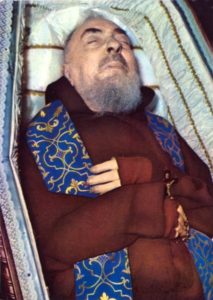 We declare that this exemplary life of Padre Pio was crowned by innumerable miracles worked through his intercession, including while he was still alive.” Saint Pio of Pietrelcina was an outstanding figure in the Apparitions of El Palmar de Troya, Seville, Spain. His apparitions to the seers of this Sacred Place were very frequent. There were periods when Padre Pio appeared in El Palmar every day, and several times a day. Furthermore, his presence in El Palmar was noted by many pilgrims through certain prodigious signs, among them perfumes. Padre Pio became visible for the first time in El Palmar de Troya while he was still alive, shortly after the apparitions began there. The stigmatized Saint’s fondness for El Palmar de Troya is not surprising, since he himself prophesied that the Most Holy Virgin would appear in a small town located between the cities of Seville and Cadiz, in Spain. In one of his apparitions in El Palmar de Troya, Padre Pio taught the recital of the Holy Penitential Rosary. Padre Pio spoke to the seers of El Palmar de Troya and, through them, imparted blessings, counsel, guidance, words of encouragement, rebukes, appreciation and so forth, to many of the pilgrims visiting this Sacred Place.
We declare that this exemplary life of Padre Pio was crowned by innumerable miracles worked through his intercession, including while he was still alive.” Saint Pio of Pietrelcina was an outstanding figure in the Apparitions of El Palmar de Troya, Seville, Spain. His apparitions to the seers of this Sacred Place were very frequent. There were periods when Padre Pio appeared in El Palmar every day, and several times a day. Furthermore, his presence in El Palmar was noted by many pilgrims through certain prodigious signs, among them perfumes. Padre Pio became visible for the first time in El Palmar de Troya while he was still alive, shortly after the apparitions began there. The stigmatized Saint’s fondness for El Palmar de Troya is not surprising, since he himself prophesied that the Most Holy Virgin would appear in a small town located between the cities of Seville and Cadiz, in Spain. In one of his apparitions in El Palmar de Troya, Padre Pio taught the recital of the Holy Penitential Rosary. Padre Pio spoke to the seers of El Palmar de Troya and, through them, imparted blessings, counsel, guidance, words of encouragement, rebukes, appreciation and so forth, to many of the pilgrims visiting this Sacred Place.
Beatified and Canonized by Pope Saint Gregory XVII the Very Great on the 12th of September 1978. Declared Doctor of the Church by the same Pope on the 6th of November 1989.
